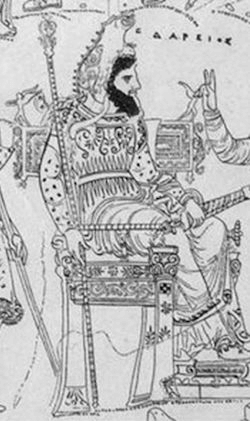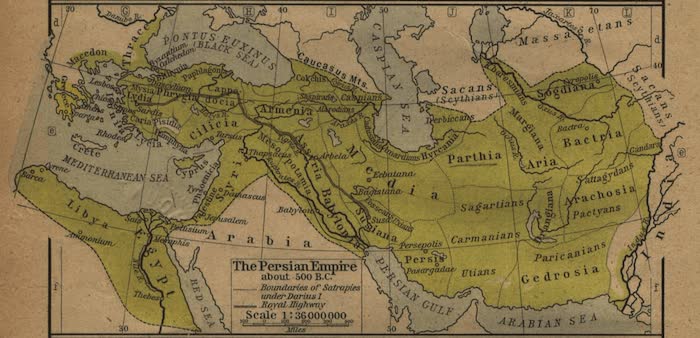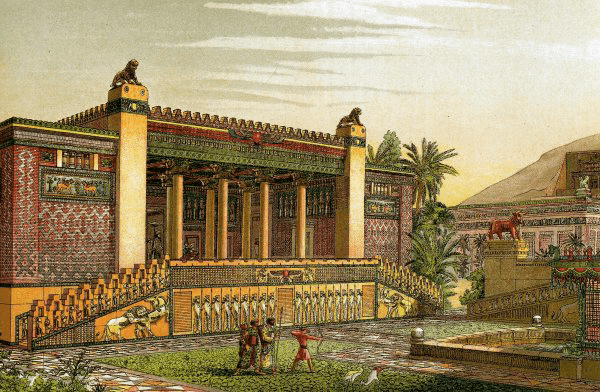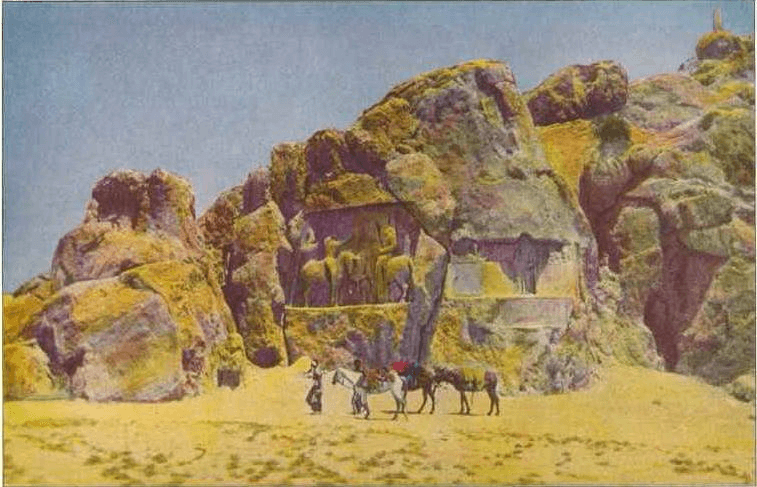Achaemenid Dynasty > Darius I
Darius I
Background
Darius I was a great and powerful ruler of the Achaemenid Empire following the death of Cyrus II the Great. One of his biggest accomplishments was creating the luxurious and opulent mountaintop capital city of Persepolis. This city was famously razed to the ground by Alexander the Great after his conquest.

Darius I Depiction From Vase - Monuments of Classical Alterums: Vol I, Plate VI (1885)
Darius I was not directly related to Cyrus the Great but after he seized power he married his daughter which provided great legitimacy to his rule. He was originally born to the satrap or governor of Parthia and forcefully took the Achaemenid throne upon the death of Cambyses II in 522 BCE.
Darius was a political genius and began a massive reform campaign aimed at organizing the Persian Empire and increasing its wealth and power. He built up many great cities throughout the empire and connected them all with roads that also aided in moving the Persian military to its vast territories. He also constructed many great monuments, buildings and other public works that all cemented his status as a great ruler.
Much of what we know about Darius comes from recovered inscriptions and the histories given by Herodotus who lived relatively contemporary with these events. He was known to have been an avid supporter of freedom of religion even if he brutally crushed all internal rebellions within the empire. He is believed himself to have practiced Zoroastrianism and was known to have facilitated in the construction of religious temples and monuments of all faiths throughout the Achaemenid Empire.
Becoming King
According to the account of Herodotus a young Darius I caught the ire of Cyrus the Great who believed he may have been plotting against him. For whatever reason Darius I was not killed and later became a general the commander of the famed Persian Immortals within the reign of Cambyses II. Cambyses was the son and rightful heir of Cyrus who later died in 522 BCE while off on military campaign in Egypt.
Upon his return to Persia general Darius killed the brother of Cambyses named Bardiya who he claimed was an imposter on the throne. No one knows weather this was truly Bardiya or an imposter but regardless in the ensuing chaos Darius claimed the throne. Upon the death of Cambyses II many of the provinces within the Achaemenid Empire began to revolt such as Babylonia, Elam/Susiana, Media, Sagartia and the Margiana region of Bactria.
In fact it was so bad during this time that the city of Babylon revolted twice and Susa three times. None of the attempts were successful because they were not organized. According to texts recovered Darius was forced to battle nine rebel commanders in 19 battles showing a lack of unification among the rebels. He was able to secure his throne and the internal borders in 518 BCE and soon he embarked upon expanding the exterior borders and improving the cities and infrastructure of the fledgling Achaemenid Empire.
Military Conquests
In 519 BCE Darius launched a military campaign against neighboring Scythia and also the civilizations of the Indus Valley known as the Harappa. Later he was attacked in Asia Minor and conquered both Thrace, Macedon. He tried to move north against the tribes across the Danube River but was unsuccessful. He moved onto secure the islands of Lemnos and Imbros in the Aegean Sea before returning back to Persia. Persian conquests throughout Greece and Asia Minor would sow the seeds of discontent for years to come. This conflict brewing would come to a head shortly before the death of Darius during a series of conflicts known as the Ionian Revolt.
Building Projects
One of the notable achievements of Darius was the steps he took to simplify the Achaemenid Empire and unify all of the disparate groups within. He created the concept of a satrapy which was essentially a provence. This idea would persist long after his death and was even assimilated into Alexander's empire as well. He also set the tribute that each satrapy would pay the empire.
He was responsible for improving infrastructure throughout the empire and also created a standard form of currency, weights and measurements. He also increased and expanded trade routes from Egypt to India and also funded many explorations of unknown territory. He was known for improving many great cities across ancient Asia and built numerous public works projects in all corners of the empire.

Achaemenid Empire (500 BCE) - Historical Atlas (1923)
In fact, Darius I was known as the greatest builder of the Achaemenid rulers. He was known to have built fortifications and a massive political center including a palace at the previous Elamite capital city of Susa. Susa later became the administrative capital of the entire Achaemenid Empire.
He was also very tolerant of all religions like Cyrus before him. Darius ordered the construction of a number of temples in Egypt to honor the gods and also ordered the Egyptian satrap or governor to consult with the Egyptian priests about the laws for the territory. In following with this in 519 BCE Darius I allowed the Jews to begin reconstruction on the Temple of Jerusalem that was located in the ancient city of Jerusalem.
Persepolis
As for the cultural and political capital of the Achaemenid Empire, Darius I ordered the construction of the great city of Persepolis. Persepolis was one of Darius' greatest achievements, this beautiful city contained a massive palace, council hall, treasury and defensive fortifications and at one point was believed to be responsible for the largest collection of wealth anywhere on the planet the time in the treasury.

Darius I Palace at Persepolis - Charles Chipiez (1835-1901)
Royal Road
The Royal Road was a massive stone highway that was to connect the furthest reaches of the Achaemenid Empire spanning 1,500 miles from Egypt to India. This was a massive engineering feat at the time because the road had to travel through nearly every type of terrain known including desert, forest, mountains, hills and everything in between.
The scope of this project was beyond comprehension in modern times and was supported by over 111 rest stations and inns spread throughout every 18 miles. It was also guarded by outposts and inns known as Caravanserai that garrisoned soldiers that saw its security from bandits and highwaymen.
Darius was believed to have finished a massive canal that connected the Nile River with the Red Sea known as the Ancient Suez Canal. Work was started many centuries before however, according to inscriptions Darius I was responsible for its completion.
Ionian Revolt
During the reign of Darius he had to deal with several of the Greek city-states under Achaemenid rule rebelling in what became known as the Ionian Revolt between 499 BCE and 493 BCE. This occurred when the cities of Athens and Eretria on the Greek mainland supported a number of revolts in the Greek colonies on Asia Minor.
These revolts were quickly crushed by the Persian Empire and soon Darius began plotting to launch campaigns to punish Athens and its meddling in Persian affairs. In 492 BCE Darius sent his son-in-law named Mardonius to command the Persian fleet and crush the Greeks once and for all and establish their total hegemony in Asia Minor. However, this did not go as planned and the Persian fleet was destroyed near Mount Athos.
Darius I tried again and in 490 BCE the Persian army invaded Greece, conquered Thrace, Macedon, and destroyed the city of Eretria and enslaved all of its people. The Persians were later defeated by Athens at the Battle of Marathon that same year. The rumored number of dead Persians to Athenians was 6,400 to 192. To the Greeks this was a historic win, to the Persians it was simply a minor annoyance on their road to world domination.
Death & Legacy
Darius I returned to Persepolis and launched a new round of building projects and was in the stage of planning a third military campaign to Greece when he died in 486 BCE. Rule was passed down to his son Xerxes I who continued his campaigns against the Greeks in what became some of the famously known battles in the world.
Darius I while ascending to rule in a brutal fashion was actually a very successful ruler like Cyrus the Great before him. He expanded Persian influence throughout the region, built dazzling cities of wealth and opulence and also firmly established military hegemony in the region. While the campaigns he launched would inevitably lead to the defeat of the Persian Empire as a whole it is not possible to say this would not have been the outcome had he stayed home.
Overall Darius I was responsible for building the Persian Empire up to new heights that had never seen seen before in history. He constructed the Royal Road, organized the Persian government, created internal security and shared more or less the same level of compassion as Cyrus himself. His legacy would have continued for much longer had the city of Persepolis not been burnt to the ground by Alexander III the Great.
Naqsh-e Rustam

Naqsh-e Rustam Photo (1921)
Darius I was buried in the mountain necropolis known as Naqsh-e Rustam along with three of his other descendants.
Sources
Primary Sources
Herodotus, Histories
Secondary Sources
Darius the Great, Jacob Abbott - Harper & Brothers, New York & London, 1850
- !blank Copy
- Abdashtart I
- Abistamenes
- Abradates
- Abrocomas
- Abrocomes
- Abulites
- Achaemenes Satrap
- Achaemenes
- Achaemenid Admirals
- Achaemenid Dynasty
- Achaemenid Generals
- Achaemenid People
- Achaemenid Satraps
- Achaemenid Women
- Ada Of Caria
- Agasias Of Arcadia
- Alcibiades
- Alexander The Great
- Amestris
- Amompharetus
- Amorges
- Amyntas II
- Amyntas
- Amyrtaeus
- Amytis Of Media
- Antidorus Of Lemnos
- Apama
- Ardumanish
- Arexion
- Ariabignes
- Ariamnes
- Ariaramnes
- Ariarathes I Of Cappadocia
- Ariarathid Dynasty
- Ariobarzanes II Of Cius
- Ariobarzanes Of Persis
- Ariobarzanes Of Phrygia
- Aristagoras
- Arsames II
- Arsames Satrap Of Clicia
- Arsames Satrap Of Egypt
- Arsames
- Arsites
- Artabanus Of Persia
- Artabazus I Of Phrygia
- Artabazus II Of Phrygia
- Artabazus
- Artaphernes Son Of Artaphernes
- Artaphernes
- Artaxerxes I Of Persia
- Artaxerxes II Mnemon
- Artaxerxes III Ochus
- Artaxerxes IV Arses
- Artaxerxes V Bessus
- Artembares
- Artemisia II Of Caria
- Artoxares
- Artumpara
- Artystone
- Arukku
- Aryandes
- Aryenis
- Aspathines
- Astyages
- Atizyes
- Atossa
- Atropates
- Autophradates
- Azemilcus
- Bagapaios
- Bagoas Courtier
- Bagoas
- Bardiya
- Battus IV Of Cyrene
- Cambyses I
- Cambyses II
- Camissares
- Cassandane
- Cheirisophus
- Clearchus Of Sparta
- Coes Of Mytilene
- Croesus
- Ctesias
- Cyaxares I
- Cyaxares II
- Cyrus I
- Cyrus II The Great
- Cyrus IV
- Cyrus The Younger
- Dadarsi
- Darius I
- Darius II
- Darius III Codomannus
- Datames
- Datis
- Deioces
- Deiokes
- Demaratus
- Democedes
- Dinon
- Dionysius The Phocaean
- Eualcides
- Eurysthenes
- Evagoras II
- Gaumata
- Gobryas
- Harpagus
- Hecatomnid Dynasty
- Hecatomnus
- Heracleides Of Cyme
- Heracleides Of Mylasa
- Hermotimus Of Pedasa
- Hippias
- Histiaeus
- Hydarnes I
- Hydarnes II
- Hyperanthes
- Hystaspes Father Of Darius I
- Hystaspes Son Of Xerxes I
- Idrieus
- Kidinnu
- Kings Of Media
- Madius
- Mandane Of Media
- Mania
- Mardonius
- Masistes
- Masistius
- Mausolus
- Mazares
- Median People
- Megabates
- Megabizus I
- Meno
- Menostanes
- Mentor Of Rhodes
- Miltiades
- Mithradates Satrap Of Cappadocia
- Mithrenes II
- Mithridates II Of Cius
- Mithridates Of Cius
- Mithridates
- Mithridatic Dynasty
- Mithrobuzanes
- Naburimannu
- Nehemiah
- Ocha
- Onesilus
- Ordumanesh
- Oroetus
- Orontes I
- Orontes II
- Orontid Dynasty
- Orontobates
- Orxines
- Ostanes Son Of Darius II
- Otanes
- Oxyathres Of Heraclea
- Oxyathres Of Persia
- Pactyes
- Parmys
- Parysatis II
- Parysatis
- Peisander General
- Pharasmanes
- Pharnabazes
- Pharnabazus I
- Pharnabazus II
- Pharnabazus III
- Pharnaces I Of Phrygia
- Pharnaces II Of Phrygia
- Pharnacid Dynasty
- Phraortes
- Phrataphernes
- Phrynichus
- Pigres Of Caria
- Pixodarus
- Pnytagoras
- Pre Achaemenid Kings
- Proxenus Of Boeotia
- Pythagoras The Spartan
- Rhoesaces
- Rodrogune
- Sabaces
- Satibarzanes
- Satraps Of Aria
- Satraps Of Armenia
- Satraps Of Bactria
- Satraps Of Cappadocia
- Satraps Of Caria
- Satraps Of Cilicia
- Satraps Of Egypt
- Satraps Of Ionia
- Satraps Of Lydia
- Satraps Of Magnesia
- Satraps Of Media
- Satraps Of Parthia
- Satraps Of Persis
- Satraps Of Phrygia
- Satraps Of Sardis
- Scylax Of Caryanda
- Scythes
- Sicinnus
- Silanus Of Ambracia
- Sisamnes
- Skunkha
- Socrates Of Achaea
- Sogdianus Of Persia
- Spalagadames
- Spithridates
- Stateira I
- Stateira II
- Strattis Of Chios
- Struthas
- Tabalus
- Tamos
- Tattenai
- Teispes
- Themistocles
- Thirty First Dynasty Of Egypt
- Thyus
- Timocrates Of Rhodes
- Tiribazus
- Tissaphernes
- Tithraustes
- Tomyris
- Tritantaechmes
- Twenty Seventh Dynasty Of Egypt
- Xenias Of Arcadia
- Xenophon
- Xerxes I
- Xerxes II
- Zerubbabel